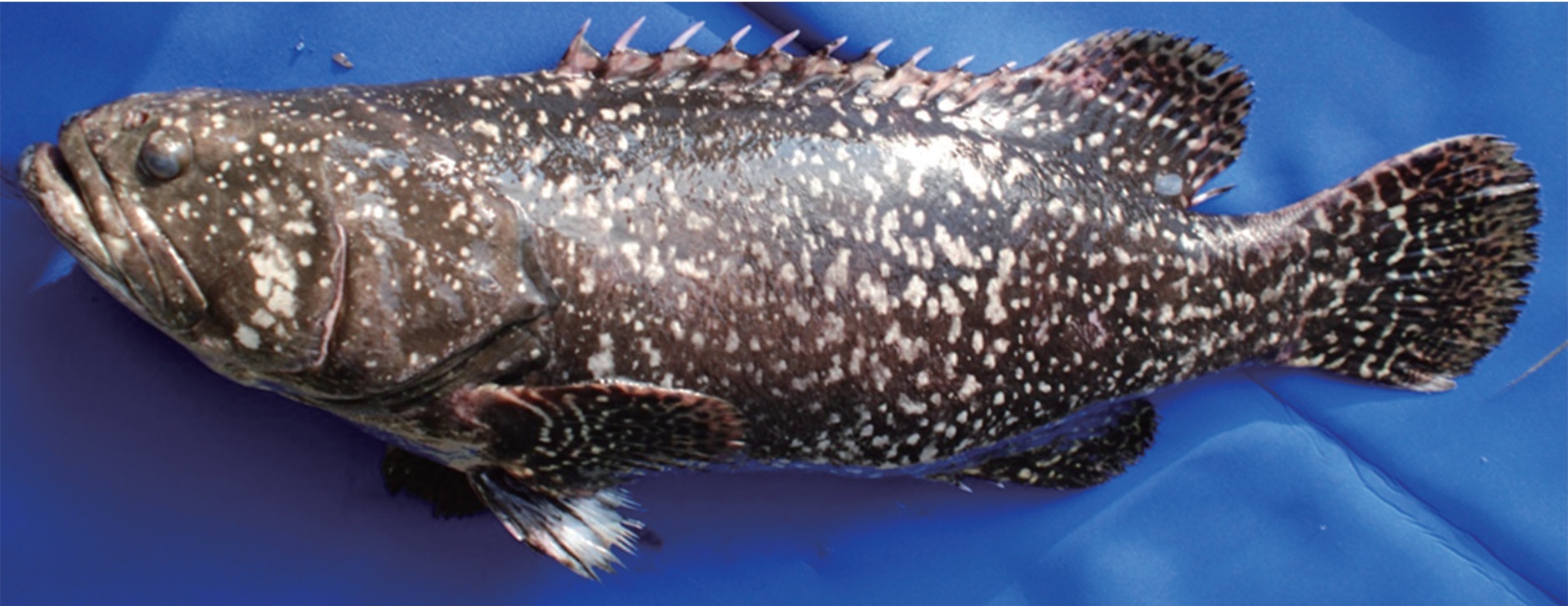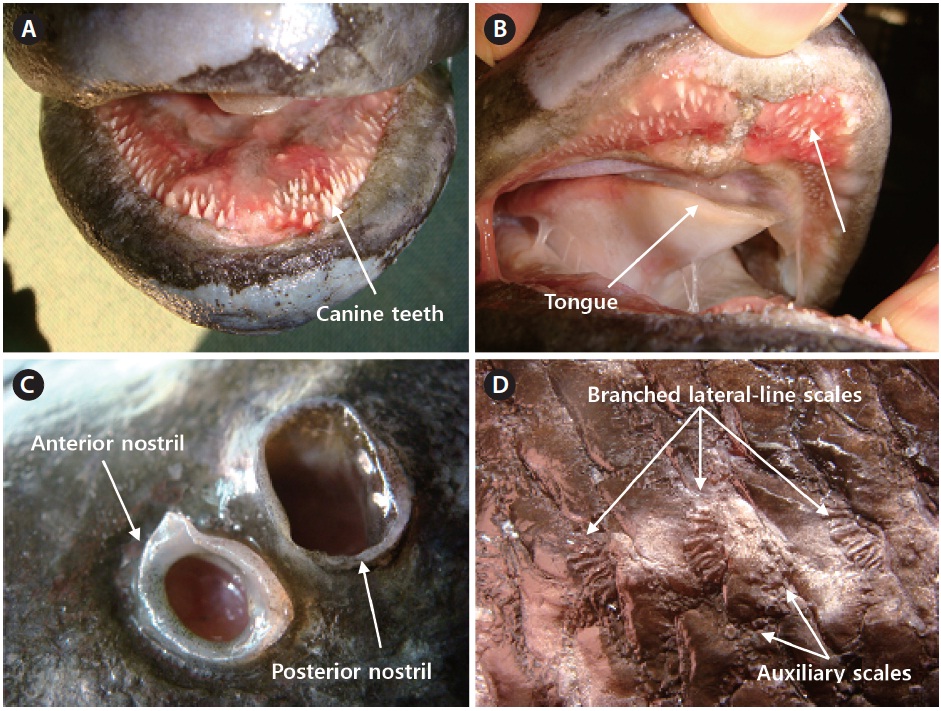The giant grouper Epinephelus lanceolatus (also known as the Queensland grouper or Reef cod) is the largest species of the family Serranidae inhabiting the tropical and subtropical waters of all three major oceans (Heemstra and Randall, 1993). Approximately 522 species belonging to 73 genera and five subfamilies in Serranidae have been reported worldwide (Eschmeyer et al., 2010). Among the genera in the subfamily Epinephelinae, the genus Epinephelus comprises some 89 species (valid names) in marine habitats around the world (WoRMS, 2012). Epinephelus species are among the most important commercial fishes in the tropical fisheries of the world. They are among the highest priced species at fish markets, and a few species are used in aquaculture ventures (Heemstra and Randall, 1993). In South Korea, thirteen species of Epinephelus have been reported so far (Han et al., 2011).
Here, we report that a single specimen of E. lanceolatus was collected from Gang-jeong Port, Jeju Island, South Korea, for the first time. We describe the morphological characteristics of the species based on this specimen.
A single specimen of Epinephelus lanceolatus was collected form Gang-jeong Port, Jeju Island, South Korea, on 28 December 2009. The specimen was photographed while fresh and then preserved in 10% formalin. Counts and measurements followed Heemstra and Randall (1993). The examined specimen was deposited at the Korea Institute of Ocean Science and Technology (KIOST), Korea.
KIOST 20091228, one specimen, 672 mm in standard length (SL), Gang-jeong Port, Jeju Island, South Korea, 28 December 2009, set net, 18 m depth, 17℃ temperature, collected by Dr. Jung-Goo Myoung.
Epinephelus lanceolatus (Bloch, 1790) (new Korean name: Dae-wang-ba-ri) (Table 1, Fig. 1)
Holocentrus lanceolatus Bloch, 1790: 92, pl. 242, fig. 1 (type locality: East Indies).
Serranus geopgraphicus: Cuvier and Valenciennes, 1828: 332 (type locality: Java).
Batrachus gigas: Gunther, 1869: 131 (type locality: Seychelles).
Oligorus terrae-reginae Ramsay, 1880: 93, pl. 9 (type locality: Queensland).
Promicrops lanceolatus: Katayama in Masuda et al., 1984: 132.
Serranus phaeostigmaeus: Fowler, 1907: 255, fig. 2 (type locality: Hawaiian Islands).
Epinephelus lanceolatus: Heemstra & Randall, 1986: 526; 1993: 174; Randall & Heemstra, 1991: 176; Kuiter, 1993: 132; Nakabo, 2002: 714; Konishi and Nakabo, 2007: 88.
Counts are shown in Table 1. Proportions are given as % of SL: body depth 31.8; head length (HL) 38.8; predorsal length 37.9; prepectoral length 29.0; preanal length 63.5; caudal peduncle length 13.9; caudal peduncle depth 14.4ons given as % of HL: eye diameter 9.8; interorbital width 28.3; upper jaw length 36.6; longest dorsal fin length 26.4; longest dorsal spine length 21.3; pectoral fin length 68.1; longest anal fin length 45.7; longest anal spine length 19.7; pelvic fin length 41.3.
Body elongate, subcylindrical and compressed. Mouth very large, posterior tip of maxilla reaches well past vertical at rear edge of eye. Interorbital space flat, the dorsal head profile slightly convex. Preopercle angular, finely serrate, the corner rounded, but no large antrose spines on ventral edge; upper edge of operclum convex. Two nostrils, sub-equal, posterior nostrils distinctly a bit wider than anterior nostrils (Fig. 2C). Mid-lateral portions of lower and upper jaws with 5-6 rows of canine teeth; tongue edentate (Fig. 2A and 2B). Dorsal fin spines shorter than rays; interspinous membranes of dorsal fin not incised, the 1st to 10th spines subequal, 11th (last) spine longest. Anal fin spines large; second is strongest. Pectoral fin, posterior ends of dorsal and anal fins, and caudal fin rounded. Pelvic fins not reaching anus. Lateral-body scales smooth cycloid; auxiliary scales present on body (Fig. 2D); anterior lateral-line scales with branched sensory tubules; very small scales on maxilla and snout.
Dark gray-brown with scattered, with irregular whitish blotches and numerous small black spots, and fins slightly yellowish with irregular blackish and whitish markings.
E. lanceolatus is distributed in the Indo-Pacific region, from South Africa to the Hawaiian Islands (Heemsta and Randall, 1993), Japan, South China, the Philippines, the Mariana Islands, Malaysia and Indonesia (Randall and Lim, 2000; Sadovy and Cornish, 2000; Myers and Donaldson, 2003), South-Eastern and Western Australia (Kuiter, 1993), and the southern coastal waters of Jeju Island, South Korea (present study). Its absence in the Persian Gulf is puzzling (Heemstra and Randall, 1993).
Epinephelus lanceolatus differs from other species of the genus by having tubules on lateral-line scales with four to six radiating branches. Except for large adults of E. malabaricus, E. itajara, and E. coioides (which have a few anterior lateralline scales with branched tubules and posterior lateral-line scales with a single tubule), the lateral-line scales of other Epinephelus have unbranched tubules (Randall and Heemstra, 1991). E. lanceolatus is closely related to E. itajara; both grow to enormous size and have a similar body shape, small eye, wide interorbital area, numerous platelets on the gill arches, short dorsal-fin spines, similar fin counts, and anterior lateral-line scales with branched tubules. However, E. lanceolatus differs from E. itajara in having cycloid scales (whereas E. itajara has ctenoid scales) on the sides of the body, and adults are vaguely mottled dark brown, the fins have numerous small black spots (whereas E. itajara have small black spots on the head and dorsal part of the body) (Heemstra and Randall, 1993, 1999). E. lanceolatus has been listed as a vulnerable species by the International Union for Conservation of Nature and Natual Resources (2012) since the mid-1980s (Shuk Man and Chuen, 2006), and this fish should be protected elsewhere. More research is needed with regard to the appearance of E. lanceolatus on the Southern coast of Korea.







